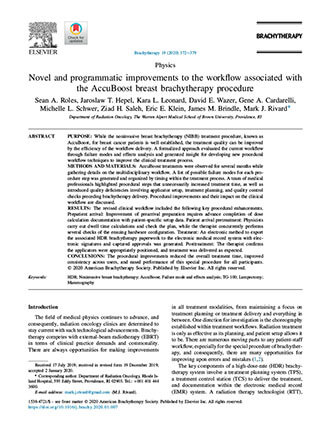Breast Brachytherapy Procedure- Improvements To The Workflow
Sean A. Roles, Jaroslaw T. Hepel, Kara L. Leonard, David E. Wazer, Gene A. Cardarelli, Michelle L. Schwer, Ziad H. Saleh, Eric E. Klein, James M. Brindle, Mark J. Rivard*
Department of Radiation Oncology, The Warren Alpert Medical School of Brown University, Providence, RI
ABSTRACT PURPOSE:
While the non-invasive breast brachytherapy (NIBB) treatment procedure, known as AccuBoost, for breast cancer patients is well established, the treatment quality can be improved by the efficiency of the workflow delivery. A formalized approach evaluated the current workflow through failure modes and effects analysis and generated insight for developing new procedural workflow techniques to improve the clinical treatment process.
METHODS AND MATERIALS:
AccuBoost treatments were observed for several months while gathering details on the multidisciplinary workflow. A list of possible failure modes for each procedure step was generated and organized by timing within the treatment process. A team of medical professionals highlighted procedural steps that unnecessarily increased treatment time, as well as introduced quality deficiencies involving applicator setup, treatment planning, and quality control checks preceding brachytherapy delivery. Procedural improvements and their impact on the clinical workflow are discussed.
RESULTS:
The revised clinical workflow included the following key procedural enhancements.
Prepatient arrival: Improvement of prearrival preparation requires advance completion of dose calculation documentation with patient-specific setup data. Patient arrival pretreatment: Physicists carry out dwell time calculations and check the plan, while the therapist concurrently performs several checks of the ensuing hardware configuration.
Breast Brachytherapy Treatment: An electronic method to export the associated HDR brachytherapy paperwork to the electronic medical record system with electronic signatures and captured approvals was generated.
Posttreatment: The therapist confirms the applicators were appropriately positioned, and treatment was delivered as expected.
CONCLUSIONS:
The procedural improvements reduced the overall treatment time, improved consistency across users, and eased performance of this special procedure for all participants.
2020 American Brachytherapy Society. Published by Elsevier Inc. All rights reserved.
